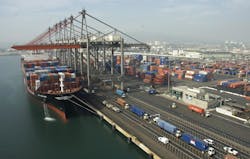More global trade, more capacity issues ahead
New analysis by the International Transport Forum (ITF) projects that international freight volumes will grow more than fourfold – by a factor of 4.3 – by 2050, with the average distance traveled by all modes to deliver those cargoes increasing by 12%.
The group also stressed in its ITF Transport Outlook 2015 that transporting such higher volumes will be problematic in the face of shrinking capacity.
“The foreseeable increase in global freight represents an unprecedented challenge for the world’s transport systems,” noted ITF Secretary-General José Viegas during a press briefing in Paris at group’s annual summit meeting. “Increasing capacity constraints in transport can act as a brake on economic growth.”
Some of the main findings from the group’s yearly analysis of the global freight industry include:
- The North Pacific route will surpass the North Atlantic as the world’s most busy trading corridor in terms of freight volume, growing 100 percentage points faster than the North Atlantic.
- The Indian Ocean trade corridor will see large growth, with freight volume quadrupling.
- Intra-African and intra-Asian freight volumes will see particularly strong growth to 2050, increasing 715% and 403% respectively, with road transport the dominant freight hauling mode for both those regions.
- The share of domestic transport of international freight flows, identified by ITF research the first time, will account for 10% of trade-related international freight.
- Carbon dioxide (CO2) emissions from freight transport will grow by 290% by 2050, with freight replacing passenger traffic as main source of CO2 emissions from surface transport.
- Additionally, domestic freight transport will account for 30% of global CO2 emissions.
“This is important [as] domestic transport is shaped by national policies, less by international agreements,” Viegas said. “A quadrupling of freight emissions can seriously undermine climate change mitigation.”
During the press briefing, Viegas highlighted four “action items” that would not only help relieve capacity issues but reduce CO2 emissions from the freight sector as well:
- Improve capacity management as many freight facilities are underutilized;
- Invest in missing links by using more alternative and multi-modal connections to increase efficiency;
- Adapt infrastructure to more and bigger vessels, dubbed “mega-ships,” including so-called “port-hinterland” connections;
- Increase vehicle utilization by improving load factors and reducing idle times across global supply chains.
